

Kumbhaka
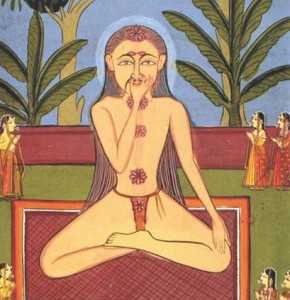 Kumbhaka in Alternate Breathing
Kumbhaka in Alternate Breathing
Kumbhaka — holding the breath while practicing Pranayama. There are basically three types of Kumbhaka:
- Bahya Kumbhaka — Kumbhaka after fully exhaling
- Antara Kumbhaka — Kumbhaka after full inhalation
- Kevala Kumbhaka — A rhythmic but very shallow and minimal breathing
Main Table of Contents
1 Sukadev on Kumbhaka
2 Swami Sivananda on Kumbhaka
2.1 First Exercise (First Variant of Anuloma Viloma or Nadi Shodana)
2.2 Second Exercise (Second Variant of Anuloma Viloma or Nadi Shodana)
Sukadev on Kumbhaka
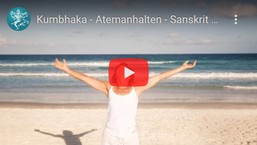
 |
 |
Swami Sivananda on Kumbhaka
There are eight different «Kumbhakas». These are:
- Suryabheda
- Ujjayi
- Sitkari
- Sitali
- Bhastrika
- Bhramari
- Murcha
- Plavini
In some books «Plavini» is defined as the eighth «Kumbhaka». In some other books, «Kevala Kumbhaka» is described as the eighth «Kumbhaka Variant». I have also described «Kapalabhati» at this point, because although it belongs to the «Shat Karmas», it is finallly nothing more than a variant of the Pranayama Exercises.
Prana is the «Vayu», the breath that moves in the body. «Kumbhaka» is the process of holding back the Prana in the body. There are two types of «Kumbhakas», namely «Sahita» (the spontaneous cessation of breathing in the advanced practice) and «Kevala» (willful holding of breath). It is hardly possible to achieve perfection in «Raja Yoga» (mind control) without having previously practiced Hatha Yoga. At the end of the «Kumbhaka Exercises», you should withdraw the mind from all external objects. With gradual and steady practice, you will gradually acquire perfect control of the mind.
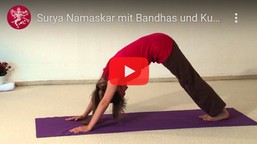
 |
 |
First Exercise (First Variant of Anuloma Viloma or Nadi Shodana)
Sit down in the «Padmasana». Close your eyes. Concentrate on «Trikuti», the point between the eyebrows. Close the right nostril with your right thumb. Inhale slowly through your left nostril, as deeply as you can comfortably. Make no noise when you inhale. Then exhale slowly. Mentally repeat your Mantra during the practice. Repeat this twelve times, that makes one round.
Then close the left nostril with your left ring finger. Inhale and exhale slowly through your right nostril as described earlier. Repeat this twelve times. Do two rounds in the second week and three in the third week. Take a five-minute rest break after each round. If you breathe in and out normally a few times after completing a round, this will give you the refreshment you need for the next round. There is no «Kumbhaka», breath holding, in this exercise. This exercise harmonizes the activity of «Ida» and «Pingala» and cleanses the «Nadis» (energy channels of the astral body).
Second Exercise (Second Variant of Anuloma Viloma or Nadi Shodana)
Sit in the «Siddhasana» or any other cross-legged position of your choice. Close the right nostril with your right thumb and slowly inhale through the left nostril. Then close the left nostril with the right ring finger, open the right nostril and exhale slowly on the right, then inhale slowly on the right, as deep as you can comfortably. Then open your left nostril and exhale on the left. There is no «Kumbhaka», breath holding, in this exercise. Repeat this twelve times, that makes one round. This exercise harmonizes the activity of «Ida» and «Pingala» and cleanses the «Nadis» (energy channels of the astral body).
Surya Bheda
«Surya Bheda» or «Surya Bhedana», literally: «the opening (Bheda) of the sun (Surya) or the sun channel (Pingala)»; is a breathing technique from Pranayama, one of the eight («Mahakumbhakas»), in which you breathe in through the right nostril and exhale through the left nostril; a breathing exercise to increase the sun energy in humans.
Caution: Do «Advanced Ujjayi» or «Surya Bheda» only after at least 3 rounds of «Kapalabhati» and at least 15-20 minutes of «Alternate Breathing» («Anuloma Viloma» or «Nadi Shodana»).
Warning
Without a prior and well-founded learning of the practices and exercises from a certified professional (e.g. Yoga Teacher), performing these practices can lead to the fact that desired effect not occurring or even damage your health!
These explanations are not intended for learning the exercises, but serve as a reminder for people who have already learned these exercises and should also simply convey theoretical knowledge about execution, variants and effects, and so on.
Table of Contents
1 Sukadev on Surya Bheda
2 Surya Bheda Effects
3 Surya Bheda Execution
3.1 Surya Bheda for Beginners
3.2 Surya Bedha for Advanced Students
3.3 Surya Bedha in Hormonal Yoga
Sukadev on Surya Bheda
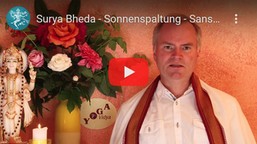
 |
 |
Surya Bheda Effects
«Surya Bheda» calms the mind, increases the vital capacity (lung volume). Increases the Prana in the whole body, cleanses the «Sushumna Nadi», awakens the «Kundalini Shakti» and pulls them up to the «Ajna Chakra» (in the full variation only suitable for advanced students). Harmonization / reduction of «Vata» (simple variation: without «Jalandhara Bandha»).
Surya Bheda Execution
Sit in «Padmasana» or «Siddhasana». Close your eyes. Close your left nostril with the little finger of your right hand. Breathe in slowly and noiselessly through the right nostril. Then hold your breath, thereby press gently your chin against your chest. Focus you on the skull and the top of the skull. This will direct the energy into the skull and cleanse the skull. Hold your breath until the roots of your hair and fingertips start to sweat.
This point cannot be reached right from the begin. You have to gradually increase the time you hold your breath until you get there. This point marks the limit of the duration of the «Suryabedha» practice for you. Then close the right nostril with your right thumb and breathe out very slowly and noiselessly through the left nostril. The exercise destroys the intestinal worms and intestinal diseases. It helps against rheumatism, ozaena and various types of neuralgia. The «Suryabedha» overcomes old age and death and awakens the «Kundalini Shakti».
Surya Bheda for Beginners
On the right, inhale only with the Abdominal Breathing, the «Mula Bandha». Hold your breath («Antara Kumbhaka») with «Mula Bandha» and «Uddhiyana Bandha» as long as it is agreeable. Exhale left, without the «Bandhas». Then hold your breath («Bahaya Kumbhaka») with «Uddhiyana Bandha». Start over (inhale on the right again). This is «Surya Bheda» for Beginners.
Surya Bedha for Advanced Students
This is how more Advanced Yoga Practitioners practice «Surya Bheda»: Breathe in completely on the right with «Mula Bandha». Hold your breath («Antara Kumbhaka») with «Maha Bandha» as long as it is agreeable. Thereby support your hands on your thighs. Exhale left, without the «Bandhas». Then hold your breath (so «Bahaya Kumbhaka») with «Uddhiyana Bandha». Start over and inhale on the right again. Concentration on the «Ajna Chakra» between the eyebrows.
Surya Bedha in Hormonal Yoga
Lie flat on your back. Put your legs down. Push the right foot to buttocks, right knee on the ground. Left foot on the right knee. Put your arms backward over your head. The left hand grasps the right wrist, stretching of the right side of the body. Loosen left hand; the left ring finger closes the left nostril. 3 x 7 times activation breaths, «Mula Bandha», tongue on the soft part of the palate, holding your breath, concentration on the tip of the nose, left hand grasps the right wrist, stretching of the right side; Loosen the left hand, the left ring finger closes the left nostril, exhale right, direct the energy to the right ovary. Finally, an abdominal contraction, that is, take your arms down, take a deep breath, hold your breath with empty lungs, place your arms backwards behind your head, inhaling and lower your arms over your belly again. Repeat with the other side.
Effects:
- Activation of the ovaries,
- Activation of the metabolism.
Ujjayi
«Ujjayi» is a breathing exercise, a breathing technic. «Ujjayi» is one of the main Pranayamas («Mahakumbhakas»), in which the glottis is slightly closed and is therefore inhaled and exhaled will be in a very controlled manner. There is «Ujjayi Pranayama», «Ujjayi Kumbhaka» and «Ujjayi Meditation». «Ud» means «to the top». «Jayi» means «triumph, victory». So «Ujjayi» is the victorious on the way up.
Table of Contents
1 Sukadev on Ujjayi
2 Ujjayi Effects
3 Ujjayi Execution
3.1 Ujjayi for Beginners
3.2 Ujjayi for Advanced Students
3.3 Ujjayi Variation 1
3.4 Ujjayi Variation 2
Sukadev on Ujjayi
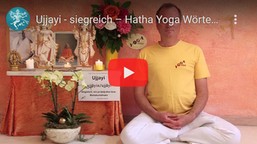
 |
 |
Ujjayi Effects
Calms the mind, increases the vital capacity (lung volume). Increases the Prana, stimulates the «Muladhara Chakra», purifies the «Sushumna Nadi», awakens the «Kundalini Shakti» (in the full variation only suitable for advanced students). Harmonization / reduction of «Kapha» and «Vata».
Ujjayi Execution
Sit in «Padmasana» or in «Siddhasana». Inhale through both nostrils, calmly and evenly. Hold your breath for as long as you can comfortably. Close the right nostril with your right thumb and slowly exhale through the left nostril. Expand your chest as you inhale. As you inhale, contract your throat slightly, this partially closes the glottis and creates a sibilant sound. The sibilant sound generated in this way should be gentle, even and persistent.
This Kumbhaka» can even be practiced while walking or standing. Instead of exhaling through your left nostril, you can also exhale through both nostrils. The «Ujjayi Breathing» removes heat out the head. It strengthens the digestive fire and helps cure asthma, constipation and lung diseases. The practitioner shines in great beauty and overcomes old age and death.
Ujjayi for Beginners
Inhale fully while controlling breath in the throat, making a slight noise. Then exhale fully while controlling the breath in your throat, making a slight noise.
Ujjayi for Advanced Students
Inhale through both nostrils (with a slight noise) with «Mula Bandha». Then hold your breath (so «Antara Kumbhaka») with «Maha Bandha». Close the right nostril with your right thumb and exhale completely (with a slight noise). Then hold your breath (so «Bahya Kumbhaka») with «Uddiyana Bandha». Then breathe in again through both nostrils and concentrate you on the «Muladhara Chakra» at the bottom of the spine.
Ujjayi Variation 1
Support your hands on your thighs near your hips.
Ujjayi Variation 2
Support your hands on the ground («Maha Vedha»).
Ujjayi Hints
- Attention: Do advanced Ujjayi only after at least 3 rounds of «Kapalabhati» and at least 15-20 minutes of «Alternate Breathing» («Anuloma Viloma» or «Nadi Shodana»).
Sitkari
«Sitkari» is one of the main Pranayamas («Mahakumbhakas») in which the air is inhaled with a hissing sound over the transversely rolled tongue. Roll your tongue up so that the tip of the tongue touches the palate. Inhale with a hissing sound and then hold your breath as long as you can without getting breath difficulties. Then exhale slowly through both nostrils. You can also do the exercise with your jaws closed, whereby the two rows of teeth slightly touching each other.
This practice rejuvenates the practitioner's body and gives it physical beauty. The need for sleep is reduced, hunger, thirst and indolence are eliminated. Do«Sitkari» when you feel thirsty and you will see that your thirst disappears immediately.
«Shitali» and «Sitkari» only differ in their tongue position: «Shitali» has a pointed roll, a cross roll, the tongue against the tooth base is in «Sitkari». For detailed information on effects, execution and variations, see also under «Shitali».
Table of Contents
1 Sukadev on Sitkari
2 Sitkari and Shitali
Sukadev on Sitkari
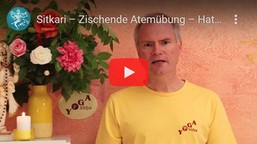
 |
 |
Sitkari and Shitali
«Sitkari» and «Shitali» are unusual Yoga Breathing Exercises because with these you breathe more through the mouth than through the nose. In «Sitkari» you press the tip of your tongue against the upper palate while slowly inhaling through your mouth, while creating a hissing sound.
After holding your breath briefly, exhale slowly through your nose. Repeat this 5 to 10 times.
According to tradition, «Sitkari» is said to embellish facial expressions. In the «Hatha Yoga Pradipika» it says: «Practicing in this way one approaches God's beauty». «Sitkari» and «Shitali» cool the body, relieve hunger and thirst. Therefore these are particularly suitable in hot weather and during a fasting cure.
With «Shitali», in this exercise you stick your tongue out a little, roll the sides upwards and form a groove in order to suck in the air when you breathe in. Close your mouth while holding your breath, then exhale slowly through your nose. If you can't roll your tongue in at first, just stick out it a little through your lips and suck in the air through your tongue. Repeat 5 to 10 times.
«Shitali» and «Sitkari» have a similar effect.
Shitali
«Shitali» or «Sitali» is one of the main Pranayamas («Mahakumbhakas»), in which the air is inhaled with a hissing sound over the tongue, which is rolled lengthwise. Overall, the exercise has a strong cooling effect. «Shitali» helps to reduce the appetite, calm the mind and harmonize energies that are out of control. Harmonization / reduction of «Pitta». «Shitali» cools the body and is good against hot flashes.
Table of Contents
1 Sukadev on Shitali
2 Shitali Execution
Sukadev on Shitali
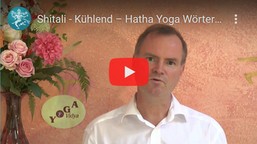
 |
 |
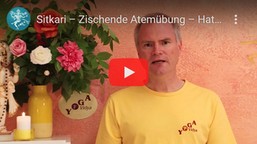
 |
 |
Shitali Execution
Roll your tongue (pointed roll — «Sitali», tongue against the base of your teeth — «Sitkari»), inhaltion («Pūraka») over the tongue with a sibilant sound. Exhalation («Rechaka») through your nose. With or without «Kumbhaka». With or without «Bhandas».
Sit in «Padmasana», «Siddhasana» or another cross-legged sitting position. Stick out your tongue so that it protrudes a little above your lips. Roll them up to a tube. Inhale through your rolled tongue with a drawn out hissing sound. Hold your breath for as long as you can comfortably. Then slowly exhale through your nose. Practice this for 15-20 minutes each morning.
This Pranayama purifies the blood; it stills thirst and hunger. Whenever you get in a place where you cannot ingest water and you are thirsty because of it, do this exercise and the thirst will disappear instantly. «Sitali» has a cooling effect on the whole organism. It eliminates chronic indigestion. It helps against inflammation of the spleen, various chronic skin ailments, fever, constipation, biliary ailments and many other diseases. The blood is cleared of all kinds of poisons. Those who practice this Pranayama will not be affected by the bites of snakes and scorpions.
Variation 1: After inhaling «Kumbhaka» with «3 Bandhas» («Maha Bandha»).
Variation 2: After inhaling «Kumbhaka» with «Khechari Mudra», «Uddhiyana Bandha», «Mula Bandha», head backwards.
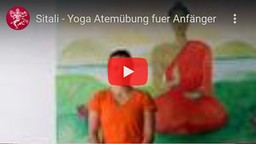
 |
 |
Bhastrika
«Bhastrika» is a breathing exercise for awakening the «Kundalini» and belongs to the «Acht Mahakumbhakas». The air is slowly drawn in through the nostrils and then expelled. «Bhastrika» has a very strong energizing effect and awakens the «Kundalini», breaks and opens the «Granthis».
Warning
Without a prior and well-founded learning of the practices and exercises from a certified professional (e.g. Yoga Teacher), performing these practices can lead to the fact that desired effect not occurring or even damage your health!
These explanations are not intended for learning the exercises, but serve as a reminder for people who have already learned these exercises and should also simply convey theoretical knowledge about execution, variants and effects, and so on.
Table of Contents
1 The Sanskrit Word Bhastrika
2 Sukadev on Bhastrika
3 Bhastrika Execution
3.1 Bhastrika Intermediate Level
3.2 Bhastrika Advanced
The Sanskrit Word Bhastrika
«Bhastrika» is sack, pouch; «Small bellows» (a yogic breathing exercise).
Sukadev on Bhastrika
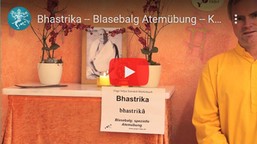
 |
 |
Bhastrika Execution
In Sanskrit, «Bhastrika» means «Bellows». The special feature of this Pranayama is the rapid succession of forced breaths. Just as a blacksmith moves his bellows in a fast rhythm, in this exercise the breath should also move quickly. Sit down in «Padmasana», the «Lotus Position» or in another very stable cross-legged sitting position. Straighten you up, keep your upper body, nape and head upright. Support yourself with your palms on your knees or on your thighs.
Inhale and exhale quickly and forcefully five to ten times. The lungs are expanded and contracted again in rapid succession, creating a powerful sibilant sound. After doing this five to ten times, breathe in as deeply as possible after the last exhalation. Hold your breath for as long as you can comfortably. When you cannot longer hold your breath comfortably, exhale as deeply as possible. This concludes a round of «Bhastrika».
At the end of each lap, take a short rest by taking a few relaxed breaths in and out. This allows you to relax and get fit for the next round. Do three rounds in the morning every day. If you want, you can also do three rounds in the evening. People who do not have enough time to practice three rounds of «Bhastrika» a day can be satisfied with one round. Even doing one round of «Bhastrika» a day will make you strong and healthy. «Bhastrika» is a very powerful practice. It is a combination of «Kapalabhati» and «Ujjayi». Some practice until they get tired. You will work up a profuse sweat as you do this exercise. If you feel the slightest dizziness during the exercise, stop the exercise and take a few normal breaths. Once the dizziness has gone, continue doing the exercise. In winter, «Bhastrika» can be performed both in the morning and in the evening. In summer it should only be done in the cool morning hours.
«Bhastrika» eliminates strep throat, strengthens the digestive fire, cleanses the body of phlegm, helps with diseases of the nose and chest, cures asthma and constipation. It is very effective against all diseases caused by an excess of gases, bile and mucus. It warms up the body a lot. If you are in a cold region and you do not have enough warm clothes, practice this Pranayama and it will give the body the warmth it needs.
«Bhastrika» very thoroughly cleanses the «Nadis», the energy channels in the astral body. It enables the Prana to break through the three «Granthis» or «Knots» (energetic blockages) that block the path of energy in the «Sushumna» and after a short time it wakes up the «Kundalini».
The number of laps done and the number of exhalations per lap should be adapted to the fitness and lung capacity of the exerciser. You don't have to go into the extremes, this is very important in this exercise. Some students do six rounds, others twelve. Mentally repeat «OM» with devotion and awareness of the meaning of the Mantra throughout the practice. There are some variants of «Bhastrika» in which the nostrils are alternately closed and only one nostril is used for breathing.
I strongly recommend that Full-Time Yogis who seriously want to practice the «Bhastrika» clean their bowels, either with the «Basti Kriya» or with an enema. They should limit their diet to «Kichery» with lots of Ghee (purified butter) or vegetable oil.
Bhastrika Intermediate Level
Breathe out slowly and firmly with your belly («Rechaka»), inhale comfortably («Puraka»). Inhalation and exhalation are equally long and equally emphasized. Approx. 12-16 times. Then hold your breath (without breathing in between) for as long as agreeable («Kumbhaka»). Then exhale and trace back.
Bhastrika Advanced
As above, but quickly inhale and exhale fully and quickly with your belly and chest (approx. 15-40 times). Maybe use an arm movement to support the breathing. After the last strong exhalation, practice «Bahaya Kumbhaka» and «Uddiyana Bandha», then close the left nostril, inhale fully on the right and hold your breath again («Antara Kumbhaka»), use «Maha Bandha», «Shambhavi Mudra», «Khechari Mudra» and maybe «Shakti Chalini». Then exhale on the left and trace back. In this exercise, the breathing limit can be approached clearly, but it don't have to be exceeded («Ahimsa»).
Bhastrika Hints
Caution:
- Do not make more advanced variations with a tendency to inner ear infections or lung problems or high blood pressure.
- Do advanced «Bhastrika» only after at least 3 rounds of «Kapalabhati» and at least 15-20 minutes of «Alternate Breathing» («Anuloma Viloma» or «Nadi Shodana»).
Bhramari
«Bhramari», literally: «bee sound breath», breathing exercise which imitates the hum of a bee (skt. «Bhramara»). This exercise belongs to the «Eight Mahakumbhakas». When you inhale you produce the sound of a bumblebee, when you exhale (after a pause) that of a bee. The exercise helps one feel joy in the heart, strengthen the voice, and increase the volume of the lungs.
Bhramari (Bee): Inhalation with a snoring sound, exhalation with a humming sound (complete Yoga Breathing). Can be done with or without «Bandhas» and / or «Kumbhaka» (holding). To develop the voice, cleanse the throat, stimulate the Chakras, improve of the breath control.
Variations: Hold your breath after inhaling and exhaling. With or without «Bandhas» or «Khechari Mudra». «Karna Mudra»: During «Brahmari» close the ear buttons with your index finger or thumb in order to hear only your own sound or, when holding, the inner sound.
Yoni Mudra: During the «Brahmari» «Yoni Mudra»: Touch the 5 senses with the 10 fingers, especially the lips, nostrils, eyelids and close the ear buttons. Promotes «Pratyahara» by bringing the energy of the senses inward.
Table of Contents
1 Sukadev on Bhramari
2 Brahmari Execution
Sukadev on Bhramari
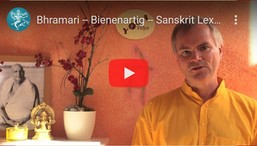
 |
 |
Brahmari Execution
Sit in «Padmasana», «Siddhasana» or another cross-legged sitting position. Breathe in and out quickly through both nostrils, imitating the humming sound of a bee as you breathe out.
Continue doing this until the body is bathed in sweat. Finally, inhale through both nostrils, hold your breath as long as you are comfortable, and then exhale through both nostrils.
Those who practice this «Kumbhaka» will experience indescribable, boundless joy. At the beginning of the exercise, the body temperature will rise as the blood circulation accelerates. Towards the end of the practice, the body cools down through sweating. The Yoga student who successfully masters this Pranayama will certainly attain enlightenment.
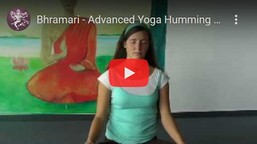
 |
 |
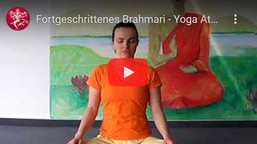
 |
 |
Murchha
«Murchha» or «Murchchha» is curdling, solidification; fainting, numb; mental numbness; a state of immersion in Hatha Yoga that is not yet the highest state («Unmani»); one of the main Pranayamas («Mahakumbhakas»), in which the breath is held for a very long time and the practitioner enters a faint-like state.
Table of Contents
1 Sukadev on Murchha
2 Murchha Execution
Sukadev on Murchha
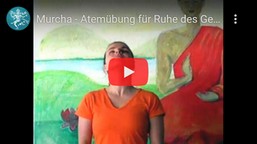
 |
 |
Murchha Execution
Sit in a cross-legged posture. Inhale. Hold your breath with «Jalandhara Bandha» by pressing your chin against your chest. Hold your breath until you feel a sense of faint coming up, then exhale slowly. That is «Murcha Kumbhaka». It breaks the contact of the mind with the senses and brings happiness.
Beginners: Breathe in on the right only with abdominal breathing, with «Mula Bandha». Holding your breath (so «Antara Kumbhaka») with «Mula Bandha» and «Uddhiyana Bandha». Exhale on the left without «Bandhas». Then hold your breath (so «Bahaya Kumbhaka») with «Uddhiyana Bandha». Start over (inhale right again).
Advanced: Inhale completely on the right with «Mula Bandha». Hold your breath (so «Antara Kumbhaka») with «Maha Bandha». Thereby support your hands on your thighs. Exhale on the left without «Bandhas». Then hold your breath (so «Bahaya Kumbhaka») with «Uddhiyana Bandha». Start over (inhale right again). Concentration on the «Ajna Chakra» between the eyebrows.
Effects: Calms the mind, increases vital capacity (lung volume). Increases the Prana in the whole body, cleanses the «Sushumna Nadi», awakens the «Kundalini Shakti» and draws them up to the «Ajna Chakra» (in the full variation only suitable for advanced students). Harmonization / reduction of «Vata» (simple variation: without «Jalandhara Bandha»).
Notes: Caution: Do «Advanced Ujjayi» only after at least 3 rounds of «Kapalabhati» and at least 15-20 minutes of «Alternate Breathing» («Anuloma Viloma» or «Nadi Shodana»).
Warning
Without a prior and well-founded learning of the practices and exercises from a certified professional (e.g. Yoga Teacher), performing these practices can lead to the fact that desired effect not occurring or even damage your health!
These explanations are not intended for learning the exercises, but serve as a reminder for people who have already learned these exercises and should also simply convey theoretical knowledge about execution, variants and effects, and so on.
Plavini
«Plavini» is one of the Pranayama Exercises in which the stomach will be filled with air. It belongs to the «Eight Mahakumbhakas». The practice of «Plavini» requires great skill. In order to learn it, it is necessary to have the practical guidance of someone who is well versed in this Pranayama.
Generally speaking, this exercise is about the practitioner «drinking» the air like water and slowly swallowing it in the stomach. While do so, the stomach is inflated a little; if you tap on it with your hand, it will produce a hollow sound. If the stomach is to be freed from the stored air again, this is done by repeated burping, or by performing «Uddiyana Bandha».
Those who have mastered this Pranayama can drift over water for any length of time. A Yoga Student could drift over water for 12 hours at a time. Anyone who is well versed in «Plavini» can be without food for a few days.
Sukadev on Plavini
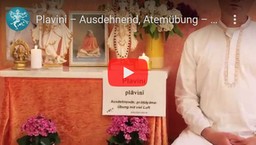
 |
 |
Warning
Without a prior and well-founded learning of the practices and exercises from a certified professional (e.g. Yoga Teacher), performing these practices can lead to the fact that desired effect not occurring or even damage your health!
These explanations are not intended for learning the exercises, but serve as a reminder for people who have already learned these exercises and should also simply convey theoretical knowledge about execution, variants and effects, and so on.
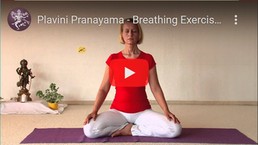
 |
 |
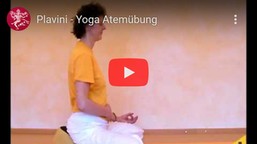
 |
 |
